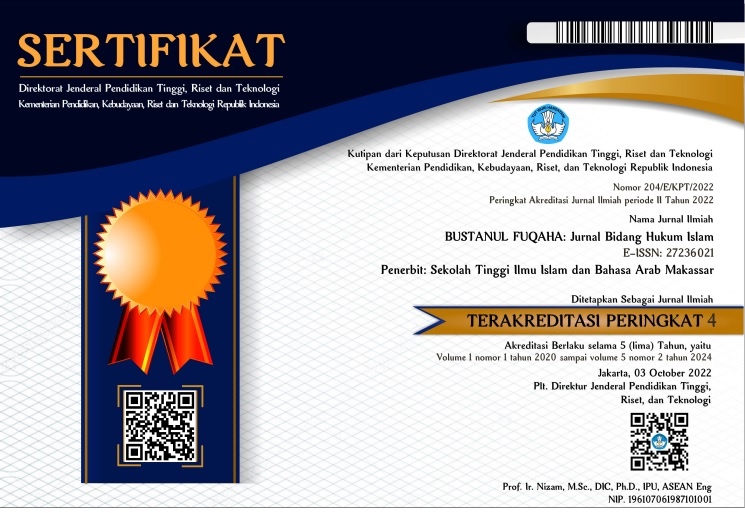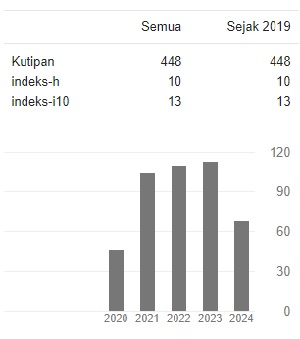Tradisi Ziarah Kubur Pasca Pernikahan (Studi Kasus Kelurahan Manisa, Kecamatan Baranti, Kabupaten Sidrap, Sulawesi Selatan)
DOI:
https://doi.org/10.36701/bustanul.v3i1.159Keywords:
Islamic Law, Tradition, Visit the Graves, MarriageAbstract
This study aimed to identify the process and purpose of the grave pilgrimage tradition after marriage in Manisa village, Baranti subdisctrict, Sidrap district, South Sulawesi, and also to examine the law of the custom in the view of Islamic law. This research employed a qualitative approach with the field study method (Field Research) and library research. The study shows that: 1. People ini Manisa village after celebrating their wedding they make grave pilgrimage in forms of such as: Determining a certain time according to the agreement of the bride and groom, preparing the necessary preparations such as water, kettles, and pandanus leaves, making ablution before going to the graveyard, praying before entering the cemetery, watering the grave with water mixed with pandanus leaves, holding the gravestone, praying for the late by reciting certain chapters finalized by surah Al-Fatihah. 2. Grave pilgrimage is one of the prescribed acts of worship but it should be in accordance with the guidance of the Prophet. As for what is found in the people of Manisa Urban Village, there are still a number of differences between what they do and what had been exemplified by the Messenger of Allah such as the determination of a special time for the grave pilgrimage, watering the grave, and seeking for blessing from the graves visited.
Downloads
References
Batanji, Ibnu. (2013). Bila Kuburan Didewakan, t. Cet; Solo: Pustaka Arafah.
Al-Bantānī, Baetī Salām. (2010). Ziarah al-Qubūr ‘alā Hadyi Rasūlullah, al-Qassīm: Maktab Da’wah.
Bin Hanbal, Ahmad. (1403 H). Al-Musnad. Cet. IV; Beirūt: Lebanon Dār al-Maktabah al-Islāmiyah.
Al-Bukhārī, Muhammad Bin Ismāīl Abu Abdillah. (1422 H). Ṡaḥīḥ Bukhārī, Juz III, Cet. I;Dār Tūqu al-Najāh.
H. Hart, Michael. (1987). 100 A Rangking of The Most Influential Person In Histori, New York: Hart Pub. Co.
Ibnu Taimiyyah, Syaikh al-Islām. (1992). Ziyārah al-Qubūr wa al-Istinjādu bī al-Maqbūri, Cet. I; [t.t.] Dār al-Ṡaḥābah lī al-Tarāṡ.
Al-Naisābūrī, Abu Husain Muslim bin al-Ḥajjāj al-Qusyairī. (2009). Ṡaḥīḥ Muslim, Cet. I; al-Qāhirah: Dār ibn al-Jauzī.
Taufik. (2018). Persepsi Masyarakat Palakka Teradap Tradisi Ziarah Kuburan Petta Betta’e Di Kabupaten Bone (Suatu Tinjauan Teologis), Skirpsi, Universitas Islam Negeri Alauddin Makassar.
Al-Tirmiżī, Muḥammad bin Isā bin Surah. (1417 H). Sunan al-Tirmidzi, juz I, Riyadh: Maktabah Ma’arif.
Al-Azdi, Abi Daud Sulaiman bin al-As’as al-Sijistani. (1997) Sunan Abi Daud juz III, Beirūt: Dār Ibnu Hazm.
Isakka (63 tahun), Ibu Pengantin Mempelai Laki-laki, Wawancara, Manisa Kecamatan Baranti Kabupaten Sidenreng Rappang 14 Mei 2019.
Kementerian Agama Republik Indonesia. (2010). Al-Qur’an Tajwid dan Terjemahnya. t. Cet. Jakarta: Syamil Qur’an.
Mustami, Muhammad Khalifah. (2015). Metodologi Penelitian Pendidikan. Cet.I; Yogyakarta: Aynat Publishing.
Tim Penyusun Kamus Pusat Bahasa. (2008). Kamus Bahasa Indonesia, t. Cet; Jakarta: Pusat Bahasa Departemen Pendidikan Nasional.
Internet:
http://manisa.raz.web.id/hal-monografi.html. Diakses pada tanggal 17 Juni 2019.
Wawancara Informan:
Ahmad, (57 tahun), Tokoh agama dan Ta’mir Masjid Nurul Yaqin Manisa, Wawancara, Manisa Kecamatan Baranti Kabupaten Sidenreng Rappang, 12 Mei 2019.
Ye’ Laini (67 tahun), Tokoh Masyarakat, Wawancara, Manisa Kecamatan Baranti Kabupaten Sidenreng Rappang 14 Mei 2019.














